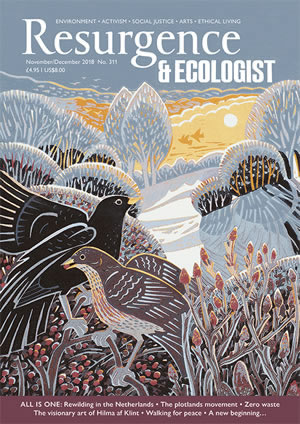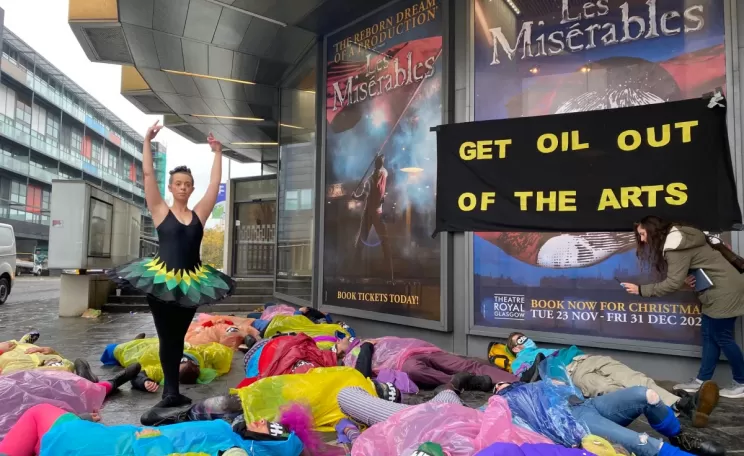x
When Susan Crawford was invited to study the knitwear at the archives of Shetland Museum she selected 27 pieces – some nearly a hundred years old.
She set about researching the makers, wearers and social history surrounding them, and painstakingly writing patterns for each one, in some cases even making her own yarn to ensure the recreation was as truthful to the original as possible.
The latest edition of Resurgence & Ecologist magazine is out now!
It was the start of the “all-consuming” Vintage Shetland Project, recently published as a book, that was to dominate her life for the next eight years.
Close attention
Much has been written about the history of the Shetland knitwear industry and how it has gained an international reputation. But Crawford’s project stands out because of the attention paid to individual garments.
Carol Christiansen, textiles curator at Shetland Museum said: “The knitting held in Shetland’s museums is exceptional because pieces are one-off creations, designed and executed by the knitter, applying the professional standards they practised for the export market to the knitwear they made for home use.”
The colours and motifs of each garment appear to reflect not only the shades and contours of Shetland’s cratered peat hills, but also the personalities of the people who made them.
One tunic, which Crawford names the ‘Suffragette’, was knitted by local political activist Christina Jamieson. Christina was a well-known local campaigner for women’s suffrage, presenting lectures and writing.
In a letter to the Shetland News around 1909 - under the nom de plumeGirzie - she wrote: “As for women being weaker, I nivver fin it said at A’m weaker in mind or boady whin der work ta du…” (“I’ve never found it said that I’m weaker in mind or body when there’s work to do”).
Simply incredible

The elaborate tunic, in natural white, blue and yellow with red motifs, is knitted using a Fair Isle intarsia technique widely used in the 1940s but very rare in Shetland at the time.
Crawford said: “The garment is simply incredible, just like its owner. It is well worn and obviously loved, and in its every stitch reflects Christina’s outspoken nature and confrontational attitude.”
In another garment, a jumper knitted by Doris Hunter for her fiancé Ralph Paterson, the darning is as much a testament of love as is the knitting itself. It has a remarkable history.
Doris spun the wool from a full Shetland fleece and other naturally coloured wools to make this Fair Isle ‘all-over’ jumper – a style highly popular in the 1920s. This cherished garment ended up with Ralph in an internment camp in Hong Kong during the second World War.
With limited resources in the camp, items such as flour sacks were unravelled to repair clothing, as were socks donated by the Red Cross.
Resurgent interest
Crawford said: “It is very likely that the jumper was darned using threads from the thousands of unwound socks, along with other remains from clothing no longer usable.
"It’s a sobering thought that after his eventual release, in late 1945, he brought part of the camp home with him – woven into the very fabric of his jumper." The jumper was kept in the family until after Doris’s death in 1987.
Crawford continued: "I hope that as a result of the project there will be many new versions of Ralph’s jumper, each of them living its own long life and with much love knitted into each and every stitch.”
The popularity of the book The Vintage Shetland Project– the first edition sold out after a few months – comes at a time when knitting is enjoying a full-hearted revival in the UK.
In Shetland too, despite concerns that knitting skills were not being passed down within families, there is a resurgence of interest.
Living heritage
After the local education authority stopped funding knitting classes in schools in 2010, local
charity the Brough Lodge Trust set up the group ShetlandPeerieMakkers to provide lessons on the island of Fetlar.
Following an injection of funding in 2017, the group now teaches in 27 schools across the archipelago.
This living heritage is something I deeply appreciate. My grandmother, born and raised in Shetland, was an incredibly skilful knitter.
I have memories of her knitting needles quietly clicking away as we all watched Saturday evening game shows on television. Her eyes barely glanced down at the work in her hands, but slowly, miraculously, the separate strands of wool meeting between her fingers would transform into a beautifully patterned arm or neck.
Years later, after a stroke left her partially paralysed, she knitted my sister and me two intricate lace scarves out of sky blue wool, using just one hand.
Creative muse
For Crawford, writing patterns for the garments in the project was no mean feat, particularly because a number of pieces had been knitted in a weight of yarn not used today.
The details of the designs would be impossible to recreate without this fine yarn so Crawford decided to manufacture her own wool, including one type of yarn spun from the organic fleeces of a flock of sheep owned by two of her friends.
These friends, and their sheep, live on Vaila, an island on the west of Shetland, a place Crawford described as her “creative muse”: “It was a connection to Vaila and its landscape that spoke to me throughout the project.
“Its history and its own interconnectivity with the stories I was researching and writing about were a significant influence in how I approached the book.”
On her Instagram page, Crawford reposts images of the knitwear readers of the book have recreated for themselves: “Each time someone knits a new version of the original garments, they are keeping the story around that garment alive".
Perpetual storytelling
She continued: “They will tell other people the story of the original, and in that way both an oral and a physical continuation of the story are maintained, and therefore the stories about the people behind the garments are also passed on and remembered.”
My own knitting skills will need quite a lot of honing before I could ever attempt knitting a lace scarf with just one hand, but I’m tempted to recreate Ralph’s jumper.
When I do, I will be thinking of him, of my grandmother, and of the wind-driven landscape of Shetland.
The Vintage Shetland Projectis published by Vintage (2018).
This Author
Marianne Brown is deputy editor of Resurgence & Ecologist. The latest edition of the magazine is out now!







